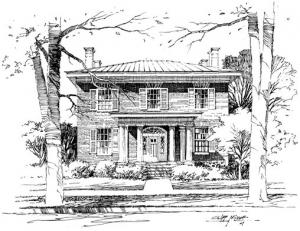Looking for design inspiration? Browse our curated collections!
July 21st, 2014 - 12:32 PM

Recently I discussed studying the styles and techniques of artists I admire, and utilizing their techniques to help develop my own special style. I am currently working on a new piece of work – this one a pen and ink drawing. I’m trying to increase my repertoire of Home Portraits and Historical Buildings art by adding pen and ink drawings to the watercolor and colored pencil paintings. By having more options for clients to choose from I hope to increase the chances of getting more commissions.
It’s been a long time since I did pen and ink work and, as with anything I work at, I first do some research on the subject. In this case it was to look up pen and ink work that I really liked, to study their styles and to use that as a basis for producing my own work. In my online search I came across three pen and ink artists that impressed me with their architectural drawings. I’m sure there are a great many more but these three provide plenty of inspiration. They are Ron Colgrove, Cliff Minor and Melissa Tubbs.
Ron Cologrove’s work impressed me the most and his pen and ink drawings were the ones I looked at the most when I was preparing mine. Although all the artists have tight styles when it comes to architectural renderings, Ron’s was a bit looser. He uses a crow quill pen with a size 102 tip, equivalent to the 3X0 Rapidograph tip made by Koh-I-Noor. Ron wrote two very fine articles describing his technique and references can be found for them on his website colgrovefineart.com. The crow quill point is flexible and allows for a variation in line thickness which I like. His rendering of the Butler House in Buffalo, NY was done in a very tight style. However, two other renderings of his I love are Kelly’s Place and Water Mill Reflections, and those were done in a looser, more painterly style rather than a technical style. Both of these drawings are pen and ink and watercolor. Even with the watercolor added, much of the tonal work seems to be done with pen and ink.
Cliff Minor (cliffminor.com) is an architectural renderer from Boone, NC, who still uses traditional methods to prepare architectural images – pen and ink and watercolor. Other architectural illustrators are beginning to use computer generated drawings. Although beautiful, I personally don’t call them art. I’m still a traditionalist also, preferring to use my hands and a brush or pen or pencil to create. Placing a computer between my hand and the paper seems so impersonal. Cliff’s style is also tight when it comes to buildings but he has, perhaps, the loosest style with trees and shrubs and landscaping. I like his handling of the surroundings because they are supporting elements and require less detail work. They are more “painterly”, as in the free flowing watercolor style. In his “watercolor added” drawings he seems to depend more on the watercolor to give tonal variety and shading. Very artistic. Unfortunately I was unable to find out what instruments of the trade Cliff uses in his line drawings.
The tightest style of the three goes to Melissa Tubbs (melissabtubbs.blogspot.com). Her handling of pen and ink yields nearly photographic work. There is a high degree of detail in both her architectural and landscape elements. Her blog includes the words “ink architecture”. I’m amazed at the level of detail in her drawings. I keep samples of her work around just to show me what is possible. Her drawings are all black and white, no watercolor added. If I was to specialize in pen and ink, she would be at the top of the list of styles to emulate. Melissa also does pencil drawings, and portraits, both human and pets. I was also unable to find out what instruments she uses to produce her drawings.
If you’re interested in improving your pen and ink work or just want to see some awsome drawings, check out these three artists.
Comments
There are no comments on this blog. Click here to post the first comment.